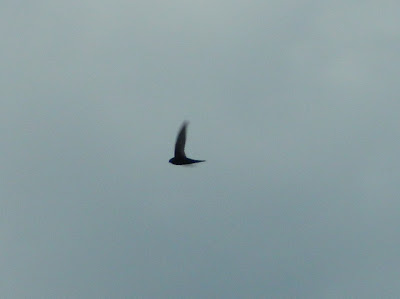 |
| Kids that followed us on a birdwatching hike imitate our use of binoculars. South of Agahozo-Shalom Youth Village, Rwanda. |
Bird = inyoni. Whenever someone eyes us suspiciously or gawks at us as we are out staring at a bird, all we have to say is “inyoni.” Hahaha, uproar and laughter! Inyoni, imagine that!
 |
| Kinyarwanda: Sarufuna, English: hamerkop (Scopus umbretta) at Lake Kivu, Rwanda |
Many of the bird names in Kinyarwanda are not specific to the species of bird, but represent a group of similar birds. For example, although there are seven types of turacos in Rwanda, some as strikingly different as Ross’s Turaco and the Great Blue Turaco, the name is the same for them all (inganji).
 |
| Kinyarwanda: sakabaka, English: black kite (Milvus migrans) at Lake Kivu, Rwanda |
“Kinyarwanda is poor,” explains Narcisse Ndayambaje, one of Rwanda’s top bird guides, based in Nyungwe Forest National Park. It is accurate that this Bantu language does not have an extensive vocabulary or much written literature historically. However, I think his explanation only partially explains the lack of more specific names. After all, despite a rich English language with all North American species having common names, most Americans probably don’t know a Northern Flicker from a Hairy Woodpecker (quite different looking woodpeckers).
 |
| Kinyarwanda: rushozera, English: square-tailed nightjar (Caprimulgus fossii) near Lake Mugesera, Rwanda |
There is not much of a bird watching hobby or ornithological discipline in Rwanda. I am not aware of any Rwandese bird scientists although there are bird guides and programs for training more park guides in bird identification.
Plus, most people here are subsistence farmers; the duties of growing most of their food take up significant amounts of time. Farming does keep them in contact with the outdoors and birds. Plenty of people know the common Kinyarwanda names for more common birds, especially the kites (sakabaka) because they will snatch their chickens or the famous grey-crowned crane (umusambi).
 |
| Kinyarwanda: umusure, English: speckled mousebird (Colius striatus) at Agahozo-Shalom Youth Village, Rwanda. |
However, nobody has binoculars. The finer details of small birds, even as noticeably different as a scarlet-chestedsunbird and a variable sunbird, are perhaps observed with the naked eye, but not represented in the language. There are German, French, English, and Latin names for nearly all the birds in Rwanda. If Rwandese people had as much time to study their birds as other visitors over the last 150 years, I would bet their birds would have Kinyarwandan common names too.
 |
| Kinyarwanda: ibijwangajwanga, English: arrow-marked babbler (Turdoides plebejus) at Agahozo-Shalom Youth Village, Rwanda |
I hope to add to this list as I learn more names. Many thanks to Narcisse and Claudien Nsabagasani for supplying me with most of the translations.
 |
| Kinyarwanda: igishwi, English: grey-headed sparrow (Passer griseus) at Agahozo-Shalom Youth Village, Rwanda |
Kinyarwanda
|
English
|
ikiyongoyongo
|
black-headed
heron, gray heron
|
akarwanamajombori
|
hamerkop
|
nyirabarazana
|
Hadada
ibis
|
igishuhe
|
geese
(wild water geese, not domestic ones)
|
imbata
|
ducks
(wild water ducks)
|
sakabaka
|
kites
|
karori
|
African
fish eagle
|
icyruzi
|
African
harrier hawk
|
icyanira
|
augur
buzzard
|
sarunfuna
|
long-crested
eagle
|
kagoma
|
eagles
|
agaca
|
small
birds of prey
|
ingagari
|
spurfowls
|
inkware
|
francolin
|
inkanga
|
guineafowl
|
umusambi
|
grey
crowned crane
|
inkurakura
|
lapwing
|
inuma
|
pigeons,
doves
|
intunguru
|
small
doves (wood-doves)
|
kasuku
|
parrots
|
inganji
|
turacos
|
ikibiribiri
|
coucals
|
igihunyria
|
owls
|
rushozera
|
nightjars
|
intashya
|
swallows,
swifts
|
umusure
|
mousebird
|
nyiramurobyi
|
kingfishers
|
imisamanzuki
|
bee-eaters
|
indonzi
|
woodpecker
|
inyamanza
|
wagtails
|
ikiyoni
|
crows
|
igikona
|
raven
|
ibijwangajwanga
|
babblers
|
ikirogoryo
|
bulbuls
|
inyomba
|
robin-chats
|
muhenera
|
sooty
chat
|
imiryasazi
|
flycatchers
|
rubamba
|
fiscals,
shrikes
|
umununi
|
sunbirds
|
igishwi
|
sparrows
|
isawdi
|
weavers
|
ifundi
|
estrilids
and other small birds
|
nyamwitenengezi
|
whydahs
|
matene
|
pin-tailed
whydah
|

i just wanted this! thank you
ReplyDeletethis has been so helpful to me
ReplyDeletecould u kindly send me the names of animals as well! (english & kinyarwanda)
ReplyDeletei lke these!!!!
ReplyDeletegive us more.
Very helpful!
ReplyDeleteThank you so much for your work... This has been so helpful. Though the list is not exhaustive but I really respect the work you've done!
ReplyDeleteThis is helpful, thank you.
ReplyDeleteMurakoze cyane!
ReplyDeleteThis is so helpful really 👏
great job! Hope you get means to take on this great challenge with the rest of the local species
ReplyDeleteGreat 👌 and help us to know inyange and inyamanza in English
ReplyDeleteI am very proud of your work here. However try correct this ► isawdi to ISANDI (weavers)
ReplyDelete